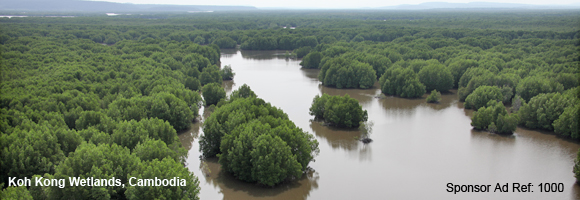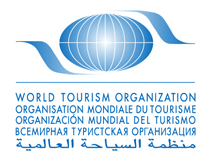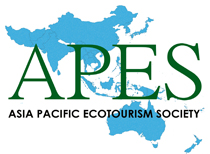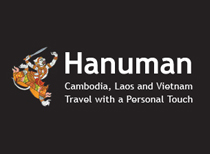Travel Information
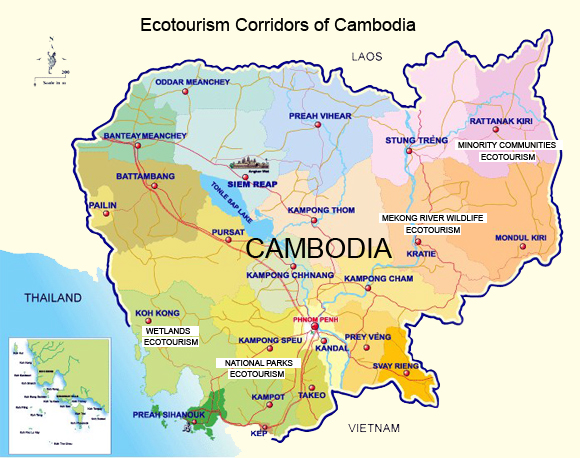
About Cambodia
The Kingdom of Cambodia, formerly Kampuchea, is a Southeast Asian nation that borders Thailand, Laos, Vietnam, and the Gulf of Thailand. The capital city is Phnom Penh. Geography
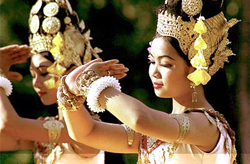 Situated in the
southwest of the Indochinese peninsula, Cambodia
occupies a total area of 181,035 square kilometers
and borders Thailand to the west and northwest, Laos
to the northeast, Vietnam to the east, and Gulf of
Thailand to the southwest.
Situated in the
southwest of the Indochinese peninsula, Cambodia
occupies a total area of 181,035 square kilometers
and borders Thailand to the west and northwest, Laos
to the northeast, Vietnam to the east, and Gulf of
Thailand to the southwest.
Cambodia’s geographic coordinates are 13 00 N, 105 00 E.
Cambodia’s terrain consists mainly of low plains, with mountains to the southwest and north.
Two dominant physical features of Cambodia are the Mekong river, which runs from north to south of the country, and the Tonlé Sap Lake.
Natural resources include oil and gas, timber, gemstones, iron ore, manganese, phosphates, hydropower potential.
Population
Cambodia’s population is approximately 14 million. Ninety per cent of residents are Khmer; the rest are Cham (Khmer Muslim), Chinese, Vietnamese, Indian, Thai, Phnorng, Kuoy, Stieng, Tamil, etc. Population density is 78/ km2.
Climate
Like most of Southeast Asia, Cambodia’s climate is hot and warm almost all year round. The climate is dominated by the annual monsoon cycle of rainy and dry seasons. The rainy season lasts from May to October, and the dry season from November to April. December to January are the coolest months, while the hottest period is in April. The average temperature is around 27-28ºC.
More Info:
Phnom Penh
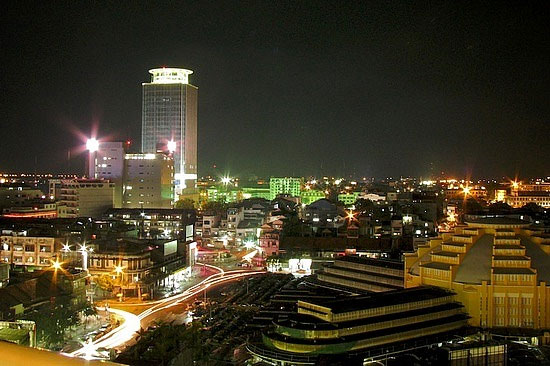
Phnom Penh, once known as the ‘Pearl of Asia’, is the capital and largest city in Cambodia. It is now a cultural, commercial, and political center that offers a unique blend of traditional charm and urban bustle.
Today, Phnom Penh is a place of diverse economic and urban growth. New highrise buildings, restaurants catering to every palate, and stylish hotels promising all levels of luxury as well as burgeoning culinary and nightlife scenes that can rival any city in the region.
The alluring capital city also features a wide variety of historical and cultural attractions, along with myriad opportunities to sample local Cambodian culture. Here, classic colonial facades endure alongside modern esplanades, golden-spired pagodas and bustling markets-- all evidence of the dynamic energy of Phnom Penh's city streets.
Phnom Penh's famous Esplanade overlooking the confluence of the Mekong River and Tonle Sap River is lined with trendy pubs, bistros, and restaurants. Stores offering beautiful Cambodian silk products and chic galleries dot the side streets. Add to this a blooming arts scene and a heady dusk-to-dawn nightlife.
Visitors may also find it
pleasant to take leisurely strolls around Phnom Penh. For a
taste of Cambodian history and royal life, visitors can tour
the Royal Palace and the Silver Pagoda
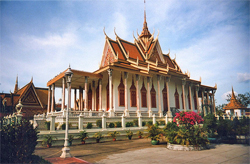 located
just next to the palace grounds. A short walk away, the National Museum beckons with room after room of Khmer
sculpture, ceramics, bronzes, and ethnographic objects. To
get a taste of city life, visitors can walk along Sothearos
Boulevard (Samdech Sothearos), sampling local foods and
patronising a clutch of ‘antique’ shops that sell silver
trays, betel boxes, belts, ancient coins, silver or wooden
statuettes and famed marble carvings.
located
just next to the palace grounds. A short walk away, the National Museum beckons with room after room of Khmer
sculpture, ceramics, bronzes, and ethnographic objects. To
get a taste of city life, visitors can walk along Sothearos
Boulevard (Samdech Sothearos), sampling local foods and
patronising a clutch of ‘antique’ shops that sell silver
trays, betel boxes, belts, ancient coins, silver or wooden
statuettes and famed marble carvings.
For those interested in shopping, the Central Market and ‘Phsar Toul Tom Poung’ aka Russian Market offers antique pieces, sundry souvenir items, and factory over-run designer clothing at hugely discounted prices. Visitors who prefer air-conditioned comfort may opt to stop in the city's modern shopping complexes (Sorya Shopping Centre, Sovanna Centre and the City Mall).
A treat at the massage centres (from US$4 - US$8) will help to relieve your tired legs. Perhaps a complete pamper at the spa for the ladies, all very reasonably priced.
A sunset cruise down Phnom Penh's Tonle Sap river serves as a perfect, relaxing end to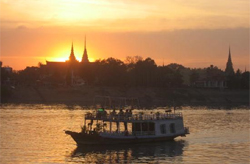 an activity-filled day. You can watch local folks and
fishermen residing by the river doing their chores. Catch
the soft river breezes and watch as Cambodia's capital
begins to light up and shimmer for the evening.
an activity-filled day. You can watch local folks and
fishermen residing by the river doing their chores. Catch
the soft river breezes and watch as Cambodia's capital
begins to light up and shimmer for the evening.
You can be rest assured of a nice dining experience with cultural performances at the Bopha Phnom Penh Restaurant & Titanic Lounge at Sisowath Quay or delight yourself with authentic khmer cuisine at Seven Bright Restaurant (Street 102).
More Info:
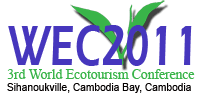 |
Interesting finds...
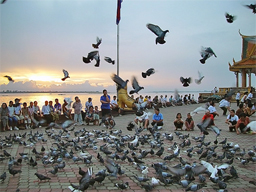
- Esplanade
- Take a stroll here, great place to hangout with locals
- Royal Palace
- Fascinate with the regal history of the Royal Family
- Russian Market
- Bazaar bargains spoilt for choice
- Central Market
- New bazaar with great bargains including gold and gem accessories
- Nagaworld
- Entertainment from casino, restaurants to lounges
- Old Market (Phsa Thmey)
- Bustling local activities for photographic extravaganza
- Seven Bright Restaurant
- Located at Street 102), serves the most delicious Kampot Pepper Crabs
- Chiva Som Spa (Sothearos)
- Khmer decor, professional and friendly services
- Bopha Phnom Penh Titanic (Sisowath)
- Overlooking the river, great for dinners
- Tonle Sap River Cruise & Sightseeing
- Capture the essence of Cambodian floating villages in one day
Read More
Note: More recommendations will be added from time to time.
National Parks along the Phnom Penh-Sihanoukville Ecotourism Corridor
Cambodian Insight (Digital Magazine)
A comprehensive digital magazine on current trends and interests in Cambodia.
Sihanoukville (Ream National Park)
The biggest and best seaside resort town in Cambodia. Sihanoukville is located on the south-west coast of Cambodia, about halfway between Thailand and Vietnam, on the Bay of Thailand. It's locally known as Kampong Som. It is a highly popular tourist town for both locals and foreigners.
Ream National Park, is located 18 km from Sihanoukville. It encompasses 210 km² including 150 km² of terrestrial and 60 km² of marine habitats.
Read More
Koh Kong (Botum Sakor National Park)
Koh Kong was recently listed by The Lonely Planet Guidebook as one of the top 10 places in the world to visit. There's a few eco-tourist lodges outside the town in the jungle and on the rivers, and hundreds of kilometers of unspoiled jungles for the real adventurer. Many destinations are only accessible by foot, boat, motorcycle or cow.
The Botum Sakor National Park comprises 183,408 hectares of designated wetlands and spans three districts of Koh Kong Province. It is flanked by the coast of the Gulf of Thailand and the Cardamom Mountains.
Read More
Kampot (Bokor National Park)
A quiet, idyllic town by the river, known not so much for tourism but for a culinary ingredient that attracts food lovers. Kampot is also known worldwide for it's Pepper Plantations (black, green, red and white table pepper) and locally for "durians" (some weighing up to 12 kilograms). The Pepper from Kampot is the only food product in Cambodia exported worldwide, and will soon have the Origin Specific label "Kampot Pepper". This is the origin of the infamous local dish - Kampot Pepper Crabs.
32 kilometers from Kampot, is the Bokor Mountain Hill Station located with the Bokor National Park. The hill station, where once stood a majestic casino, is now an abandoned town surrounded by lush vegetation of the Bokor National Park. However there are plans to re-develop the hill station into a grand leisure theme park with hotels and entertainment.
Kep (Kep National Park)
Kep is a small seaside town near to the Cardamom Mountain. Just offshore are a motley of Cambodian and Vietnamese islands. It's a half hour drive from Kampot and 2 hours from Sihanoukville and here, you probably get the freshest seafood in Cambodia.
Kep National Park is a national park of Cambodia in the Kep region of Cambodia. Established in 1993 it covers an area of 50 square kilometres.
Read More
Kampong Speu (Kirirom National Park)
Kampong Speu, west of Phnom Penh and almost on the capital's doorstep, is a province that’s often overlooked, but an ideal place to get off the beaten track. Speu is the Khmer word for “starfruit”, but Kampong Speu is actually famous for its palm sugar, which is considered the best in the Kingdom. The province also produces plenty of teuk t'not chu, or palm wine.
Kirirom National Park is located mostly in Phnom Sruoch District, Kampong Speu Province, while a smaller section is in neighbouring Koh Kong Province.
Read More

